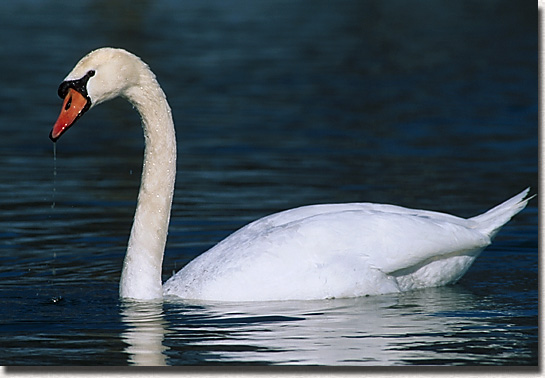Cygnus olor
Mute Swan
Synonym(s):
Class: Aves
Order: Anseriformes
Family: Anatidae

Photographer: Bill Horn
Source: http://www.birdsofoklahoma.net/photogaly.htm
Description
The mute swan (Cygnus olor) is a large bird with a total length of 56-62 inches and an average weight of 25-30 lbs. Typical of many swans, the mute swan is white with an orange bill and two black knobs. Males and females are very similar with only differences occurring in slightly large beak knobs and body size of males. While in the water, mute swans form a hump with their wings to hold them out of the water. Juvenile mute swans are a gray with a slightly darker gray beak. The mute swan was not named for its inability to make noise, in fact the mute swan is fully capable of making noise including hissing noises when it feels threatened.
Ecological Threat: Mute swans are aggressive birds that exhibit fierce behavior when defending their nests, which forces other native bird species to find new nesting and feeding sites. Mute swans are also known for showing aggressive behavior towards people visiting beaches. Aquatic ecosystems are greatly threatened by mute swans due to the large amounts of aquatic vegetation consumed on a daily basis. An average, male mute swan will consume 8 lbs of submerged aquatic vegetation each day throughout the year. In areas of high mute swan density, aquatic vegetation populations are reduced severely, forcing native fish and invertebrate species to find shelter and hiding places in a different area.
Biology: In captivity the mute swan has been observed to nest in groups, but in the wild mating pairs will nest separately from others. Mute swan nests are laid along the edge of the water, and are known to be used several consecutive years by the same mating pair. Clutch size can range from 5 to 12 eggs, with an average of 6, incubated by the female for 35 to 42 days. Parental care of offspring (cygnets) has been observed until the breeding season of the following year. Mute swans reach maturity at 2 years of age, but don't begin mating until 3-5 years of age. Some mute swans will form mating pairs after 1 year of life, but mating doesn't occur until the third year.
History: Introduced from Europe in the 1800's, mute swans escaped captivity and became established in several areas across the United States.
U.S. Habitat: The mute swans prefer estuarine river habitats along the coast, but some populations can be found in large lake habitats. The greatest density of mute swans is found in Canada, indicating a preference for cooler weather and water temperatures. The mute swan is known for eating large amounts of aquatic vegetation with an average consumption of 8 lbs per day.
Distribution
Native Origin: Europe
U.S. Present: Mute swans can be found in several states on the East coast from New Hampshire to Florida, states west to the great lakes, and some populations as far west as Washington.
For a map of partial distribution provided by EDDmapS click here.
Resembles/Alternatives
The mute swan can be mistaken for trumpeter swans and tundra swans, which are native to the east coast and can be found inhabiting areas near the mute swan.
Management
As a result of increasing populations of the mute swan, several states along the East coast are taking lethal action to remove mute swan populations to prevent further increase of establishment. If populations weren't managed, it is estimated that the current 3,600 mute swans would reach 22,000 within ten years in the Chesapeake Bay area alone. Local wildlife officials have determined that relocating and adopting out mute swans would not be effective in dealing with the high number of swans present along the east coast.
Text References
Bech, Claus. 1979. Body temperature, metabolic rate, and insulation in winter summer acclimatized mute swans (Cygnus olor). Journal of Comparative Physiology 136(1): 61-66.
Birkhead, Mike. 1982. Causes of mortality in the mute swan Cygnus olor on the river Thames. Journal of Zoology 198(1): 15-25.
Internet References
http://www.dnr.state.md.us/dnrnews/infocus/muteswanfacts.html
http://www.dec.ny.gov/animals/7076.html
 Texas Invasive Species Institute
Texas Invasive Species Institute